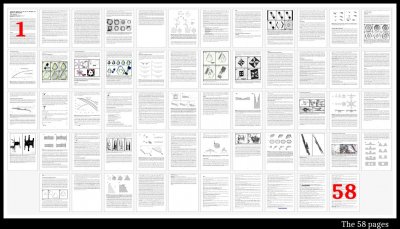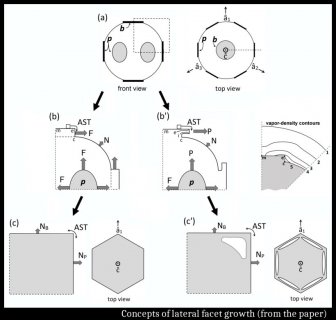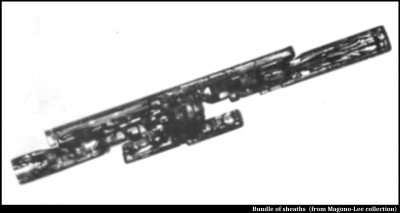| « Drainage Lines on Snow | Dark lines in melting snowpiles » |
Thinking Laterally in Crystal Growth…and in Science Publishing
After a long period of work (on and off), we have an accepted paper on the corner pockets we discovered (see here). But during the writing stage, I thought about collecting earlier ideas I had developed during my correspondence with Prof. Akira Yamashita in Japan, and as a result, the paper ballooned. Originally, it was to be a short note about the pockets, but in the end, the central theme was instead the new notion of the lateral (or sideways) growth of crystal facets. Actually, one type of lateral growth had been long known, sometimes called "facet spreading", but we collected together three types of lateral growth and describe how two of them are particularly useful for explaining a wide range of observed features on snow and ice crystals.
But before describing some of our findings, recall that all science publishing costs money. Almost always the research grant pays the page charges. However, our grant ran out three years ago, and this paper is particularly expensive (estimate: $3600) because we needed many pages to argue our points and show how lateral growth can explain many growth forms. If you can contribute, we will gladly send a signed copy of the paper acknowledging your help. Or, if you have just enjoyed some of the articles on this blog and would like to help me continue, you can contribute here as well. Here is the link:
https://www.gofundme.com/f/publish-a-research-paper-on-snowcrystal-formation
The paper in its submission format is 58 pages: (as always click on the image to enlarge)
The published format will reduce the length a little (mainly shrinking the figures), but it will still be much longer than the standard 10-15 page paper.
One key figure to help explain some of these "lateral" concepts appear in Fig. 2, reproduced below. This figure shows a just-frozen droplet, which is often called a "droxtal". Crystal facets have appeared for eight faces, shown as the shaded flat regions in the top sketches.
The middle row (b) shows the facets spreading. As we show in our data, much of this is driven by molecules flowing over the top of the facets, building into the sides as marked "AST" in the sketch. This facet spreading we term "F-type" lateral growth. The other non-trivial type is "P-type", which was discovered recently by Prof. Akira Yamashita in Japan. P refers to the protrusion it creates, and thus this is also called "protruding growth". (The third type is "S-type", but it is trivial and leads to no new phenomena.) One result of the P-type is that it can form air pockets, as shown in (c') at bottom.
In fact, there is no other plausible way to form air pockets in snow crystals. And when you start looking, you see air pockets everywhere in them.
The sketch shows one other type of growth, N growth. This is the standard "normal growth" that cloud physicists and crystal growers have always focused on. The term normal refers to the motion of the surface or facet in the "normal" direction, that is, outward. (Mathematically, the surface normal is the arrow pointing straight out of the surface, perpendicular to the surrounding surface.)
When the three types of growth are combined, one can see how previously inexplicable growth forms can develop. We examine a half-dozen or so in the paper, but here let me mention two. First, the scroll:
The scroll can appear by itself, for example in the columnar regime near -5 C and high supersaturations, and also as an extension on other crystal forms, generally starting as a sheath. I often see scrolls in hoar frost. Another previously inexplicable form is the bundle of sheaths:
Now a sheath is like a straight planar extension, generally with two or more planes meeting at a common edge. Picture yourself folding a piece of paper in half, then opening the crease up to about a 90 to 120 degree angle and standing it on the desk. This paper has the shape of a sheath. A bundle of sheaths is just a cluster of these sheaths, all attached and with their creases pointing in the same direction. Sheaths and bundles of sheaths are very common crystals.
Both of these forms can be explained by the sequences shown in the following sketches.
For example, in the top row, a sheath has started extending from the base crystal, crease pointing straight out of the page. The two sides, or 'wings' grow out as shown due to P-type growth. As this occurs, the sheath thickens, and the edges develop facets that spread (F-type growth). One is marked "p3". From these new facets, new P-growth occurs as shown at right. Under slightly different situations, such a sequence leads to the scroll in the middle row and the sheath-bundle at bottom. As far as I know, neither form had seen a serious attempt at explanation before. They were both baffling crystal shapes within the framework of our previous understanding of snow-crystal growth. Of course, the explanations proposed in the paper need more experimental tests to see if they hold up to the reality of nature. But in the meantime, at least I am not perplexed by the strange crystal forms.
The paper goes through these and other crystal types, as well as other crystal features. I will try to describe some of them in future posts. In the meantime, contribute if you can. Myself, and my co-author would greatly appreciate it. Thanks.
--JN




